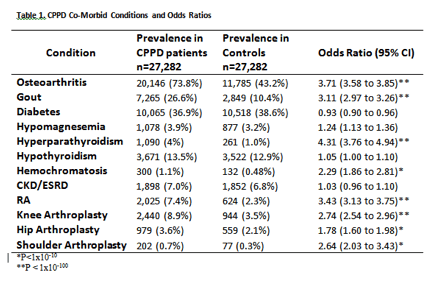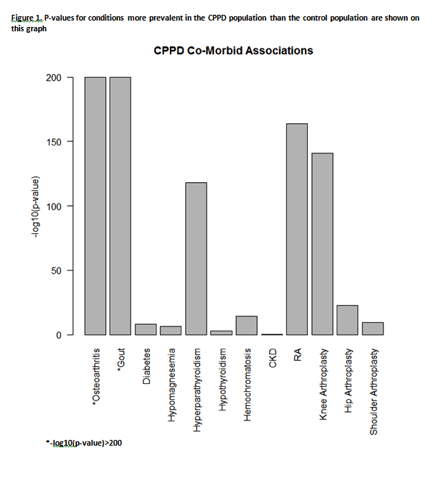Session Information
Date: Tuesday, November 10, 2015
Title: Metabolic and Crystal Arthropathies II: Mechanisms and Associations
Session Type: ACR Concurrent Abstract Session
Session Time: 4:30PM-6:00PM
Title: Calcium
Pyrophosphate Deposition Disease and Associated Medical Co-Morbidities in the
Veteran Population.
Background/Purpose: Precipitation of calcium pyrophosphate dihydrate (CPP) crystals in articular tissues results in a
variety of clinical presentations collectively called CPP crystal deposition
disease (CPPD). The cause of CPPD remains unknown and no evidence-based
treatments are available. Some risk factors for CPPD have been identified
including aging, prior joint trauma, and various metabolic conditions. The
objective of this study was to identify patient characteristics and medical
conditions associated with CPPD in the veteran population using data from the
Veteran Affairs’ (VA) Corporate Data Warehouse using previously validated ICD-9
codes.
Methods: This cross-sectional case control
study included patients seen at any VA medical center from 2010 through 2014
with ICD-9 codes for CPPD. Cases were age-matched with a control population
that also received care at a VA facility in the same time frame and lacked
ICD-9 codes for CPPD. Prevalences of various
co-morbidities were examined in each cohort. Univariate
odds ratios were computed to examine the association between CPPD and each
condition.
Results: A total of 54,564 (27,282 CPPD cases;
27,282 Controls) patients were included (Table 1). The conditions having the
strongest associations with CPPD included osteoarthritis (OR, 3.71; CI, 3.58 to
3.85), gout (OR, 3.11; CI, 2.97 to 3.26), hyperparathyroidism (OR, 4.31; CI,
3.76 to 4.94), rheumatoid arthritis (OR, 3.43; CI, 3.13 to 3.75), and
hemochromatosis (OR, 2.29; CI, 1.86 to 2.81). Hypothyroidism, hypomagnesemia, diabetes, and chronic kidney disease did
not appear to be associated with the disease. Knee, shoulder, and hip arthroplasties were more common in the CPPD cohort.
Conclusion: This data set contains the largest
study population of CPPD patients examined to date. We confirm known disease
associations with conditions such as osteoarthritis, gout, hemochromatosis, and
hyperparathyroidism. Interestingly, there was not a significant
association between CPPD and hypothyroidism, chronic kidney disease, or
diabetes, and the difference in rates of hypomagnesemia
was not statistically significant. In contrast, an interesting association
with rheumatoid arthritis was noted which could reflect diagnostic mimicry or
concomitant disease. CPPD patients also had higher rates of total joint
replacements, particularly for knee arthroplasty. We
anticipate that this data set could shed additional light on this understudied
disease.
To cite this abstract in AMA style:
Kleiber Balderrama C, Lans DS, Rosenthal AK, Bartels CM. Calcium Pyrophosphate Deposition Disease and Associated Medical Co-Morbidities in the Veteran Population [abstract]. Arthritis Rheumatol. 2015; 67 (suppl 10). https://acrabstracts.org/abstract/calcium-pyrophosphate-deposition-disease-and-associated-medical-co-morbidities-in-the-veteran-population/. Accessed .« Back to 2015 ACR/ARHP Annual Meeting
ACR Meeting Abstracts - https://acrabstracts.org/abstract/calcium-pyrophosphate-deposition-disease-and-associated-medical-co-morbidities-in-the-veteran-population/


